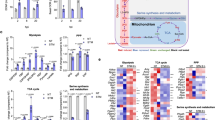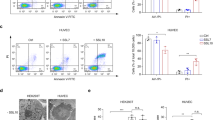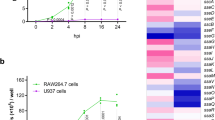Abstract
pRST98 is a chimeric plasmid isolated from Salmonella enterica serovar Typhi (S. typhi) that mediates the functions of drug resistance and virulence. Previously, we reported that Salmonella plasmid virulence (spv) genes were present in S. typhi. In our current study, we investigated whether plasmid pRST98 exhibits significant cytotoxicity in macrophages. pRST98 was transferred into the avirulent Salmonella enterica serovar Typhimurium (S. typhimurium) strain RIA to create the transconjugant pRST98/RIA. The standard S. typhimurium virulent strain SR-11, which carries a 100-kb virulence plasmid, was used as a positive control. The bacterial strains were incubated with a murine macrophage-like cell line (J774A.1) in vitro. Apoptosis of J774A.1 cells was examined by electron microscopy and flow cytometry after annexin-V/propidium iodide labeling, and the survival of Salmonella strains in J774A.1 cells was determined. Results showed that macrophages infected with strain pRST98/RIA displayed greater levels of apoptosis than those infected with RIA and that pRST98 may increase bacterial survival in macrophages. Further studies showed that the pRST98-induced death of macrophages was associated with the loss of mitochondrial membrane potential and that pRST98 may activate caspase-9 and then caspase-3. The research data indicate that the virulence of bacteria that contain the pRST98 plasmid is enhanced; the presence of this plasmid increases the survival of the bacterial pathogen and acts through the mitochondrial pathway to mediate macrophage apoptosis.
This is a preview of subscription content, access via your institution
Access options
Subscribe to this journal
Receive 12 digital issues and online access to articles
$119.00 per year
only $9.92 per issue
Buy this article
- Purchase on Springer Link
- Instant access to full article PDF
Prices may be subject to local taxes which are calculated during checkout







Similar content being viewed by others
References
Siddiqui FJ, Rabbani F, Hasan R, Nizami SQ, Bhutta ZA . Typhoid fever in children: some epidemiological considerations from Karachi, Pakistan. Int J Infect Dis 2006; 10: 215–222.
Huang R, Mu RP . Surveillance of the antibiotic resistance and R plasmid of Salmonella typhi. Chin J Infect Dis 1994; 12: 204–206.
Kurita A, Gotoh H, Eguchi M, Okada N, Matsuura S, Matsui H et al. Intracellular expression of the Salmonella plasmid virulence protein, SpvB, causes apoptotic cell death in eukaryotic cells. Microb Pathog 2003; 35: 43–48.
Soto SM, Rodriguez I, Rodicio MR, Vila J, Mendoza MC . Detection of virulence determinants in clinical strains of Salmonella enterica serovar Enteritidis and mapping on macrorestriction profiles. J Med Microbiol 2006; 55: 365–373.
Huang R, Wu SY, Zhang XG, Zhang YY . Molecular analysis and identification of virulence gene on pRST98 from multi-drug resistant Salmonella typhi. Cell Mol Immunol 2005; 2: 136–140.
Chanana V, Ray P, Rishi DB, Rishi P . Reactive nitrogen intermediates and monokines induce caspase-3 mediated macrophage apoptosis by anaerobically stressed Salmonella typhi. Clin Exp Immunol 2007; 150: 368–374.
Chander H, Majumdar S, Sapru S, Rishi P . 55 kDa outer-membrane protein from short-chain fatty acids exposed Salmonella enterica serovar Typhi induces apoptosis in macrophages. Antonie Van Leeuwenhoek 2006; 89: 317–323.
Zhou X, Mantis N, Zhang XR, Potoka DA, Watkins SC, Ford HR . Salmonella typhimurium induces apoptosis in human monocyte-derived macrophages. Microbiol Immunol 2000; 44: 987–995.
Grant AJ, Sheppard M, Deardon R, Brown SP, Foster G, Bryant CE et al. Caspase-3-dependent phagocyte death during systemic Salmonella enterica serovar Typhimurium infection of mice. Immunology 2008; 125: 28–37.
Zaki MH, Fujii S, Okamoto T, Islam S, Khan S, Ahmed KA et al. Cytoprotective function of heme oxygenase 1 induced by a nitrated cyclic nucleotide formed during murine salmonellosis. J Immunol 2009; 182: 3746–3756.
Schwan WR, Huang XZ, Hu L, Kopecko DJ . Differential bacterial survival, replication, and apoptosis-inducing ability of Salmonella serovars within human and murine macrophages. Infect Immun 2000; 68: 1005–1013.
Gulig PA, Curtiss Roy III . Cloning and transposon insertion mutagenesis of virulence genes of the 100-kilobase plasmid of Salmonella typhimurium. Infect Immun 1988; 56: 3262–3271.
Schneider HA, Zinder ND . Nutrition of the host and natural resistance to infection. V. An improved assay employing genetic markers in the double strain inoculation test. J Exp Med 1956; 103: 207–223.
Carsiotis M, Stocker BA, Holder IA . Salmonella typhimurium virulence in a burned-mouse model. Infect. Immun 1989; 57: 2842–2846.
Roe DE, Weinberg A, Roberts MC . Mobile rRNA methylase genes coding for erythromycin resistance in Actinobacillus actinomycetemcomitans. J Antimicrob Chemother 1996; 37: 457–464.
Takahashi S, Nagano Y . Rapid procedure for isolation of plasmid DNA and application to epidemiology analysis. J Clin Microbiol 1984; 20: 608–613.
Fink SL, Cookson BT . Pyroptosis and host cell death responses during Salmonella infection. Cell Microbiol 2007; 9: 2562–2570.
Takaya A, Suzuki A, Kikuchi Y, Eguchi M, Isogai E, Tomoyasu T et al. Derepression of Salmonella pathogenicity island 1 genes within macrophages leads to rapid apoptosis via caspase-1- and caspase-3-dependent pathways. Cell Microbiol 2005; 7: 79–90.
Das S, Devaraj SN . Effect of Hemidesmus indicus R.Br. root extract against Salmonella enterica serovar Typhimurium-induced apoptosis in murine macrophage cell line (P388D1). Indian J Med Res 2008; 128: 647–657.
Birmingham CL, Brumell JH . Autophagy recognizes intracellular Salmonella enterica serovar Typhimurium in damaged vacuoles. Autophagy 2006; 2: 156–158.
Kim GS, Kim DH, Lim JJ, Lee JJ, Han DY, Lee WM et al. Biological and antibacterial activities of the natural herb Houttuynia cordata water extract against the intracellular bacterial pathogen salmonella within the RAW 264.7 macrophage. Biol Pharm Bull 2008; 31: 2012–2017.
García-del PF, Núñez-Hernández C, Eisman B, Ramos-Vivas J . Growth control in the Salmonella-containing vacuole. Curr Opin Microbiol 2008; 11: 46–52.
García-Calderón CB, Casadesús J, Ramos-Morales F . Rcs and PhoPQ regulatory overlap in the control of Salmonella enterica virulence. J Bacteriol 2007; 189: 6635–6644.
Browne SH, Hasegawa P, Okamoto S, Fierer J, Guiney DG . Identification of Salmonella SPI-2 secretion system components required for SpvB-mediated cytotoxicity in macrophages and virulence in mice. FEMS Immunol Med Microbiol 2008; 52: 194–201.
Hochmann H, Pust S, von Figura G, Aktories K, Barth H . Salmonella enterica SpvB ADP-ribosylates actin at position arginine-177-characterization of the catalytic domain within the SpvB protein and a comparison to binary clostridial actin-ADP-ribosylating toxins. Biochemistry 2006; 45: 1271–1277.
Sy LK, Yan SC, Lok CN, Man RY, Che CM . Timosaponin A-III induces autophagy preceding mitochondria-mediated apoptosis in HeLa cancer cells. Cancer Res 2008; 68: 10229–10237.
Acknowledgements
We are grateful to Professor Roy Curtiss III, The School of Life Sciences, Arizona State University, USA, for kindly supplying S. typhimurium strains SR-11 and RIA. We also thank Professor Jie Yan, Zhejiang University, China, for providing murine macrophage-like cell line J774A.1. This study was supported by the Natural Science Foundation of China (No. 30972768), the Special and General Postdoctoral Science Foundation of China (No. 200902529 and No. 20080430178), the Natural Science Foundation of Jiangsu High Education Institute of China (No. 08KJB310009) and the Social Development Science Foundation of Suzhou City of China (No. SS08025).
Author information
Authors and Affiliations
Rights and permissions
About this article
Cite this article
Wu, S., Li, Y., Xu, Y. et al. A Salmonella enterica serovar Typhi plasmid induces rapid and massive apoptosis in infected macrophages. Cell Mol Immunol 7, 271–278 (2010). https://doi.org/10.1038/cmi.2010.17
Received:
Revised:
Accepted:
Published:
Issue Date:
DOI: https://doi.org/10.1038/cmi.2010.17
Keywords
This article is cited by
-
Salmonella enterica Serovar Typhi Plasmid Impairs Dendritic Cell Responses to Infection
Current Microbiology (2012)



